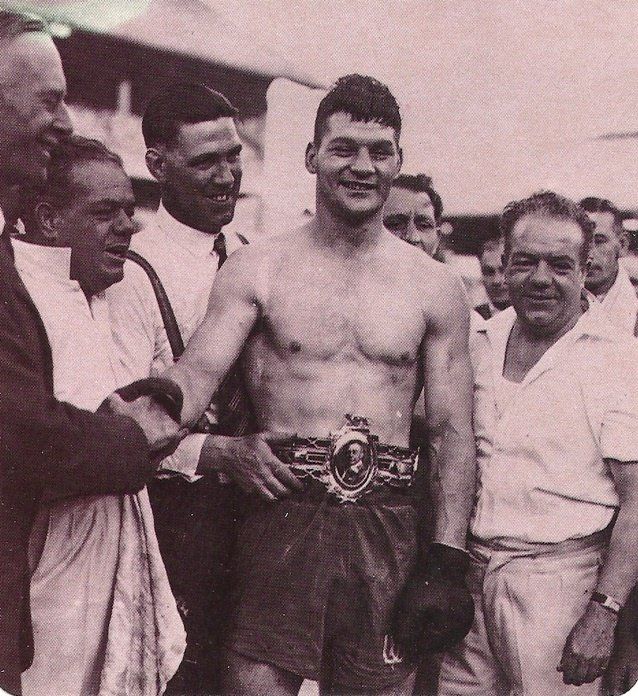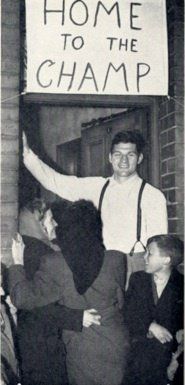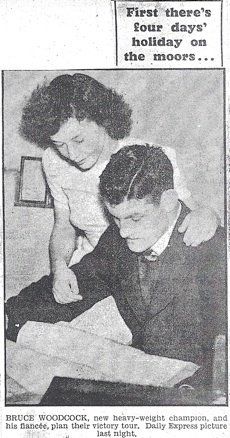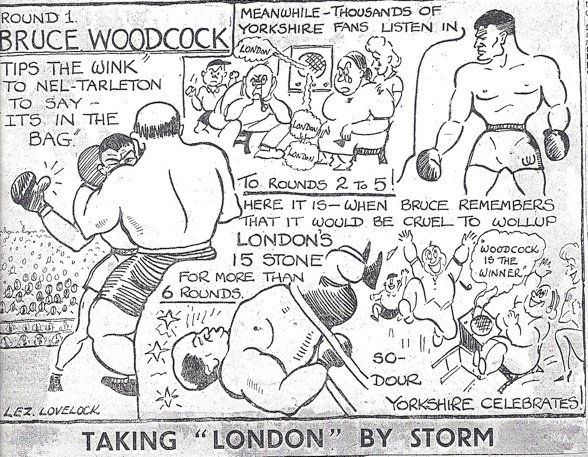
BruceWoodcockBoxer.co.uk
17th July - Woodcock vs Jack London: The British & Empire Heavyweight Championship
When the gong sounded for round one, Bruce began the fight cautiously enough, avoiding close encounters with the much heavier London by dancing away from him, following the game plan Tom Hurst had worked out with him. But London seemed far from confident, crouched and lumbering with ponderous swings which Bruce evaded easily. As the film commentator noted, Bruce was ‘more upright, gloves well up, chin well tucked in’, and snapping straight lefts in reply that jabbed London’s face and sent his head back. According to the reporter from the News Chronicle, it was then that Bruce winked over London’s shoulder across at Nel Tarleton in his corner. Tarleton said afterwards:
‘It meant Bruce knew that the fight was his from that moment. I gave him that one-two punch. He possesses it naturally. I saw its possibilities when he came to me one day in my gym and I showed him how to develop it.’
Bruce tried it a few times in the opener, but the killer one-two was another five rounds away.
Bruce tried it a few times in the opener, but the killer one-two was another five rounds away.
In the second, Bruce’s lefts kept jabbing with insistent regularity. He evaded a dangerous hook from London and scored a right cross in retaliation, backed up by another straight left. London tried to get Bruce into clinches which the referee had to break up. The same patterns recurred in the next two rounds, and the crowd must have begun to think they were in for the long haul.
But things hotted up in the fifth, which was the closest Bruce came to trouble. London rushed from his corner into the fray, seemingly determined to nail his opponent. London kept harrying him with attacks to the body and caught him with a big left punch to the side of the face, leaving a cut to the nose, followed by a left to the mouth, swelling his lip. London sensed his chance and followed through by driving Bruce into the ropes, and was still attacking to the body as the bell went. It took some of the wind from Bruce’s sails, slowing him up such that he looked tired going back to his corner, and even more so sat on his stool while his team worked on him. But we can see Tom Hurst talking fervently as he helps Bruce to a much needed swig of water, and whatever he said, it worked.
The climax came out of the blue two minutes into the sixth round. Bruce took the fight straight back at London, catching him with two heavy right hooks. And then he caught London with two short rights that sent him down on his back over the bottom rope, out of the ring, and although he got back up immediately, he was obviously hurt and dazed. Bruce knew it was his moment, and he took it: he hit London hard, a left and right, two lefts to the face, and then twice, with lightening right hooks on the chin, sending him crashing to the canvas. The crowd were already on their feet; the noise was unbelievable. London struggled to get up, even as far as his hands and knees, but the count beat him - he would say later that he couldn’t hear it for the roaring of the crowd. But even if he had made it, it wouldn’t have mattered: it’s clear from the film that he was finished, and Bruce was hovering like a terrier, ready for him had he got up.
Britain had a new British Empire Heavyweight Champion - Bruce Woodcock - and Yorkshire had its first national heavyweight boxing champion since William ‘Iron’ Hague of Mexborough in 1909.
1945 - Victory in Tottenham
Amid the uproar that followed, Bruce had a few seconds to dance up and down in the ring, gloves high in the air, before being swamped by people. The photographs of him sporting the famous Lonsdale belt show a man absolutely delighted but at the same time completely calm and composed.
He was never one to be phased by fame or adulation, or for the West End parties that Solomons and the ring-side celebrities invited him to that night. To the disappointment of the media, just beginning to really believe that here was a potential world champion, the most Bruce wanted in the aftermath of his greatest triumph was to get back home for ‘a cuppa’.
1945 - The Media React and a Well Deserved Break
The press gave him his due and applauded a magnificent performance.
The Daily Mirror’s reporter commented:
Bruce Woodcock is a worthy champion and gained a clear-cut victory. [. . .] Woodcock boxed superbly throughout, and punched with his full body weight behind every blow.’
And Jimmy Wilde, the former world flyweight champion, wrote a sharp and incisive insider’s analysis in which he assessed Bruce as ‘top rank’ and likely to become 'The best of the bunch’ [see Archive 1945 once uploaded].
Suitably, the BBC transmitted the fight live on their General Forces Programme, from 7.15-8.30 p.m.
It was the first time one of Bruce’s bouts had received such coverage.
This is how David Kynaston describes it in his history of the period:
... some 27,000 Londoners packed into the Spurs ground at White Hart Lane to see Doncaster’s Bruce Woodcock win the British and Empire heavyweight titles with a sixth-round knockout. ‘For Jack Solomons, the promoter, the fight was a triumph,’ the local Tottenham paper noted. ‘The crowd paid from 5/- to 10 guineas to see it. About 5,000 came by cars which lined each side of 30 side streets around the ground.’ On the radio, clashing with a transmission of Peter Grimes [Benjamin Britten’s opera, which was being broadcast on the Home Service between 7.00 and 10.00], Raymond Glendenning’s plummy, excitable commentary was complemented by the magisterial inter-round summaries of W. Barrington Dalby.” [David Kynaston, Austerity Britain, Bloomsbury 2007, p. 72]
Bruce’s purse for this night’s work was £1,500, which must have seemed like a fortune when he found out, driving back up the Great North Road. And when he got back home to Mona Road at something like 5.00 a.m., there was a reception committee of family, friends and neighbours to cheer him in, and a big congratulatory welcome home to ‘The Champ’. Carr Hill had been buzzing all night, and the next morning when he woke to go over to Manchester to see Nora, the crowd carried him shoulder-high all the way up ‘The Long Drop’, passed draped bunting, flying flags and banners, like a re-enactment of V.E. day two months earlier.
1945 - Back to Business
After that, prospects were beginning to mount up. Tom Hurst was getting offers from American promoters and talking of arranging a meeting with Gus Lesnevitch. That wouldn’t happen for another year.
Instead, a bout was arranged with Martin Thornton for August [see 1945 Part 3], while boxing commentators indulged in frenzied speculation over the suitability of various prospects and the urgency of keeping up the appropriate level of opponents, in the States if not at home.
As an interim, Bruce delighted 3,000 local fans with an open-air exhibition match at Doncaster Racecourse, organised by officials and employees of the L.N.E.R. Plant Works, with proceeds for the endowment of a bed at Doncaster Royal Infirmary to commemorate the championship. He fought three rounds each against Bill Brennan and Johnny Summers, and then Mr L. Reeve, mechanical engineer at the Plant, formally handed him the Lonsdale Belt, which had been presented after the championship fight but had stayed in London to be newly-engraved with his name.
Meanwhile, Bruce had to get back to training, to work in the fitting shop at the Plant putting safety valves on Pacific-type engines, but also taking time to visit his old school at Oswin Avenue to talk to the boys about boxing and visiting the Wentworth Show with Nora, where they were given a celebrity welcome.
In the meantime, the American magazine Ring placed him as second leading light-heavyweight in the world, behind Lesnevitch but ahead of Freddie Mills.
At home, by the end of the year in the ranking of outstanding sports stars for 1945 he was again placed second, after jockey Gordon Richards and before snooker genius Joe Davis. Suddenly he was a super-star, 1940s style.



